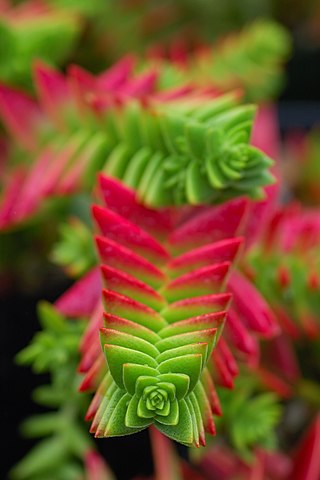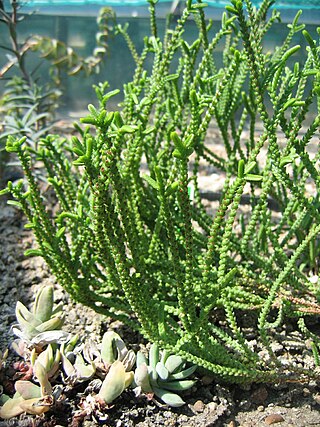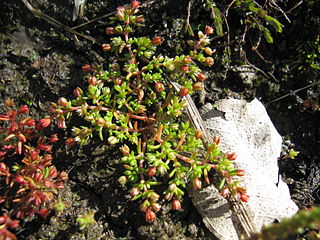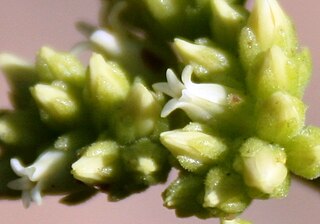
Crassula is a genus of succulent plants containing about 200 accepted species, including the popular jade plant. They are members of the stonecrop family (Crassulaceae) and are native to many parts of the globe, but cultivated varieties originate almost exclusively from species from the Eastern Cape of South Africa.

Bauhinia bowkeri is a species of legume in the family Fabaceae. It is a scrambling shrub or small tree found only in South Africa, where it is threatened by habitat loss.

Faurea is a genus containing 16 species of flowering plants in the protea family which occur in the summer rainfall area of southern Africa, extending to tropical Africa and Madagascar. The name honours South African soldier and botanist William Caldwell Faure (1822-1844) who was killed on active service in India.

Crassula muscosa, synonyms Crassula lycopodioides and Crassula pseudolycopodioides, is a succulent plant native to South Africa and Namibia, belonging to the family Crassulaceae and to the genus Crassula. It is a houseplant grown worldwide and commonly known as rattail crassula, watch chain, lizard's tail, zipper plant and princess pines.

Crassula capitella, is a perennial succulent plant native to southern Africa.

Parinari capensis, the sand apple, is a species of flowering plant in the family Chrysobalanaceae. It is found in Botswana, DRC, Mozambique, Namibia, South Africa, Tanzania and Zimbabwe. It is 20 centimetres (7.9 in) tall. The leaves are elliptic with a white underside. It has small white flowers and a hairy sand-coloured calyx.

Crassula nudicaulis is a succulent plant native to South Africa, and Lesotho.

Crassula cotyledonis is a succulent plant endemic to the arid Namaqualand and Karoo regions of South Africa.

Crassula decumbens, commonly known as rufous stonecrop, cape crassula or spreading crassula, is a herb in the family Crassulaceae that is native to southern parts of Australia, South Africa, and Chile. There are generally two accepted varieties: Crassula decumbens var. decumbens and C. decumbens var. brachyphylla.

Crassula brevifolia is a succulent plant in the family Crassulaceae. It is native to the arid western edge of South Africa as well as southern Namibia.

Crassula subaphylla is a succulent plant belonging to the family Crassulaceae. It is widespread in the Karoo regions of South Africa and Namibia.

Crassula atropurpurea is a succulent plant, very common and widespread in the southern Karoo regions of South Africa and Namibia.

Crassula pellucida is a creeping, succulent ground-cover, or low-growing, spreading succulent shrub. It is native to eastern and southern Africa, ranging from Kenya and Angola to South Africa.

Crassula perfoliata is the type species of the genus Crassula, in the succulent/flowering plant family Crassulaceae, where it is placed in the subfamily Crassuloideae. Formally described by Linnaeus in 1753 as one of 10 species of Crassula, the plant is endemic to Southern Africa, where it may be found in Eswatini, Mozambique, South Africa and Zimbabwe.
Othonna purpurascens is a species of flowering plant in the family Asteraceae. It is endemic to South Africa.

Crassula sarmentosa, commonly known as trailing jade plant and showy trailing jade, is a perennial succulent plant in the family Crassulaceae. It is native to southern Africa.















